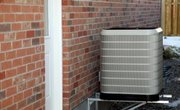
You can shield your sensitive equipment from electromagnetic fields, mostly radio frequencies or an electromagnetic pulse, with a Faraday cage. If you want to be able to include yourself in the protective space, the best way is to build a small room with 2 by 4 beams and finely woven brass or copper mesh or hardware cloth, then to ground the mesh with a copper wire and a copper or brass ground rod driven into the outside ground.
- Tape measure
- 2 by 4-inch beams
- 1/2-inch plywood
- Saw
- Brass or copper screen door mesh
- Hand stapler
- 1/2-inch staples
- Hammer
- Nails
- 2x2-inch wood strip
- Two door hinges
- Safety hasp with screws
- Screwdriver
- Rubber mats
- 4-gauge insulated copper wire
- Brass grounding rod
Measure out a floor plan for your cage, indoors but next to an outside wall. Plan the height 6 inches taller than you.
Attach a plywood floor to your existing floor.
Unroll mesh over the plywood, overlapping seams an inch everywhere. Extend the mesh 3 inches past the edges of the flooring. Stretch the mesh and use the hand stapler to attach it to the flooring.
Use hammer and nails, 2x4-inch beams and common wall construction practices to build three walls with 24-inch on-center stud spacing. The length of the walls should match the floor length and width. Nail them together and down over the floor screen.
Build the door wall with a 30-inch gap for the door, and attach it to the rest of the structure. Nail horizontal beams between the two side walls, 16 inches apart on center, for the roof.
Cut and nail together a door frame using 2 by 2-inch strips to fit the wall opening with 1/2-inch gap on each side. Use the screw driver to attach upper and lower hinges to the door and the door opening so when the door is hung, it is flush with the outside wall surface and swings in and out easily.
Screw the hasp to the inside of the door and frame.
Staple the 3 inches of excess floor screen vertically to the outside walls. At the door sill, slit the sides, wrap it over the sill and staple it down. Cover the roof beams with mesh as you did the floor, stapling the excess to the side walls. Cover all side walls with mesh, top edge to bottom edge. At the door frame, cut mesh an inch in from the edge, wrap inward and staple.
Cut and staple the door covering with 2 inches to spare around the door. Leave it flat to overlap the wall mesh when closed. Lay rubber mats inside to protect the mesh and prevent static build-up. Attach copper wire to mesh, run it through the wall to the outside, drive the brass rod into the ground, and attach the copper wire to it by wrapping.
Things You'll Need
About the Author
Jan Benschop started writing professionally in 1979. His corporate technical writing clients included Nortel, Alcatel and Glaxo. Also the author of several short stories, Benschop holds a Bachelor of Science in English from Campbell University. He built loudspeakers for more than a decade and has several international patents pending in the field.
Photo Credits
Jupiterimages/Photos.com/Getty Images
